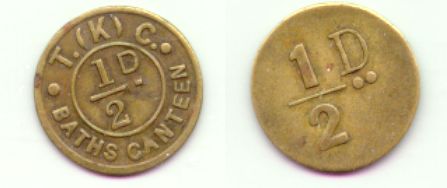
Some previously unrecorded Pithead bath tokens from Tilmanstone Colliery.
One of the challenges in token collecting is the attempt to identify those checks/tokens that have obscure legends or dubious provenances associated with them. However, one frustration is the frequent negative outcome following extensive enquiries to identify such pieces despite them having clear legends and designs plus other features that should more readily aid their identification. The three tokens illustrated below (Fig. 1a to 1c) are examples of such token enigmas which I hope the reader will agree can now be more confidently identified and attributed to a particular British colliery.

Fig. 1a : T. (K) C. - half penny token.
Obv: · T. (K) C. · / BATHS CANTEEN inscribed around ½D within a circle. Raised rim.
Rev: ½D
Edge: Plain, 20 mm, Brass.
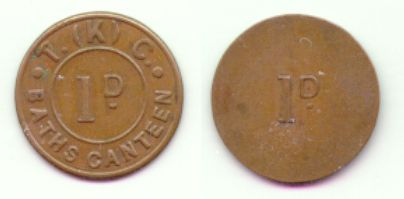
Fig. 1b : T. (K) C. -
one penny token.Obv: · T. (K) C. · / BATHS CANTEEN inscribed around 1D within a circle. Raised rim.
Rev: 1D
Edge: Plain, 20 mm, Copper.
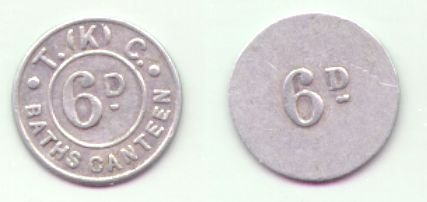
Fig. 1c : T. (K) C. -
six penny token.Obv: · T. (K) C. · / BATHS CANTEEN inscribed around 6D within a circle. Raised rim.
Rev: 6D
Edge: Plain, 20 mm, Aluminium.
It was a chance encounter with the above tokens and a 1935 list of Colliery owners that suggested their possible origin as being Tilmanstone Colliery in Kent. The particular entry in the list is illustrated (Fig. 2) indicating, if the provenance is correct, that the tokens were a private coal company issue prior to nationalisation under the National Coal Board in 1947.
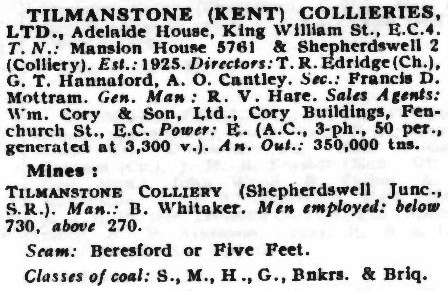
Fig.
2 : Official title and entry for Tilmanstone Colliery Company Ltd. in O'Connell’s Coal Trade Directory and Manual (London, 1935).This title of Tilmanstone (Kent) Collieries Ltd. was also used on official Company correspondence and paper work (Fig. 3).
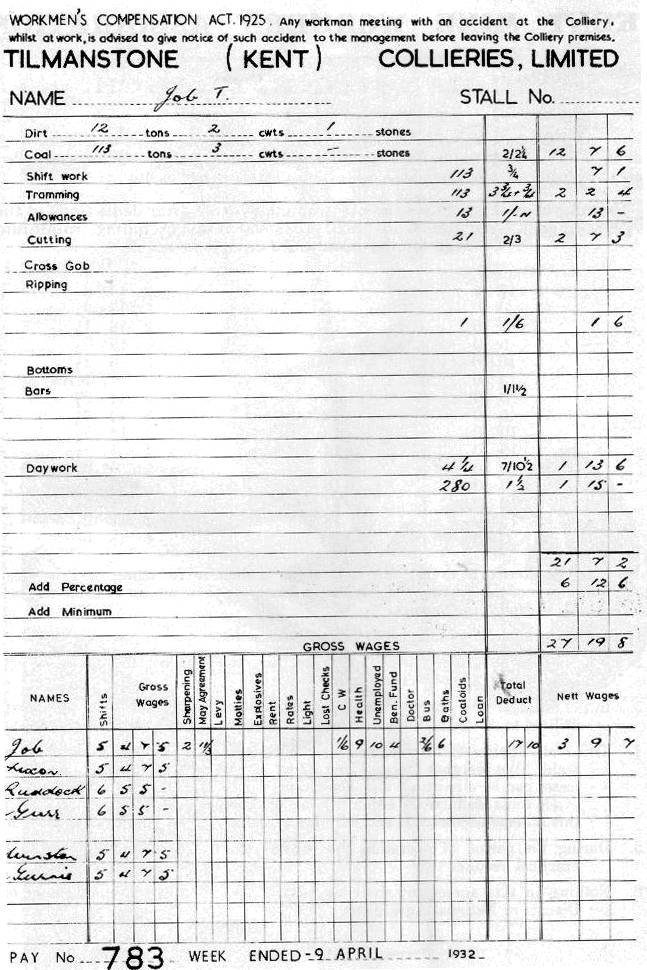
Fig.
3 : An official miner's pay slip from Tilmanstone Colliery of 1932. Note the correct company title "Tilmanstone (Kent) Collieries Limited".It appears that the small size of the tokens precluded inscribing the company name in full, which had to be shortened to initials. Similarly the word "Pithead" was omitted.
As early as 1907 Royal Commissions had recognised the value of colliery Pithead baths, but few of these had been established. In 1927 a levy of 1/- in the pound on coal royalties was commenced to augment resources of the Miner’s Welfare Fund and to secure at all coal mines facilities for workmen to take baths and to dry clothes. This in general terms constituted the Baths Fund.
Emmanuel Shinwell M.P., Secretary for Mines, opened Tilmanstone Colliery’s Pithead baths (Fig. 4) in 1930. Built at a cost of £10,000 to a standard pattern as a single storied cubicle block, a subway led from the colliery to the baths. There was provision for 1,008 lockers with areas for boot greasing and filling of water bottles. Six pence per week was deducted from the miner's wages for use of the baths, but this was discontinued in 1934 when the money was provided from the Amenity Fund.
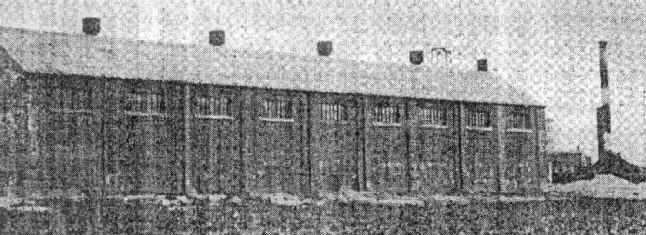
Fig.
4 : Tilmanstone Colliery Pithead Baths (Dover Express).The foregoing background information appeared to be a promising start, but confirmation regarding provenance was required as well as an enquiry concerning the possible issue of other denominations. Tokens of only three units of value were small in quantity when compared with, for example, the 7 values of the Pithead baths tokens issued by Gresford Colliery (Cox & Cox, 141-147). Nevertheless, various collectors who held T. (K) C. tokens in their collections were able to confirm only three values appeared to have been issued. These they referred to as a set. The tokens do appear to be the minimum number of values necessary for the purchase of low cost goods or services, and the differing composition of the tokens more especially the high value 6d aluminium, makes for easy recognition. A collector mentioned that a number of these tokens had been found some years ago in Folkestone, not far removed from the Tilmanstone area and it was thought then that they had a Kent connection. However, research at local level proved negative. Ex-miners who had been employed at Tilmanstone were unable to confirm the use of any tokens at their Pithead baths. A similar situation exists in South Wales, with ex-miners denying that tokens were used at any of their old Pithead baths. Purchases of soap etc. having been paid for in cash. An exception was Penallta Colliery in the Rhymney Valley from whence some presumably pre 1947, roll-type paper tickets appeared to have been used. These were issued in ½d, ld and 6d denominations (as in the case of the T.(K) C. tokens) and appear to have been used in both the Pithead baths and Canteen. As yet their exact method of use has not been ascertained.
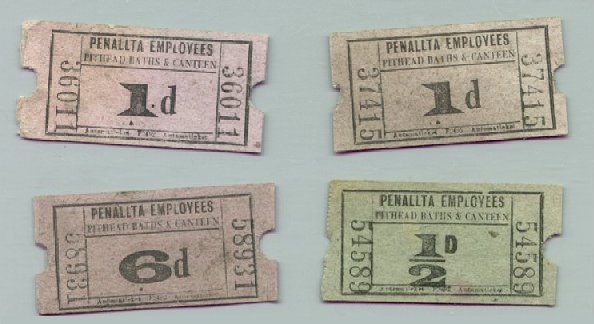
Fig.
5 : A selection of paper ticket type Pithead baths & Canteen tokens from Penallta Colliery, South Wales.Named Pithead baths (/Canteen) tokens are recorded incredibly sparsely, which is surprising given that most collieries by the 1950’s had been provided with such amenities. I have unconfirmed reports of less than twenty different types of such tokens from the United Kingdom. Countywide there were only 50 Pithead baths in 1929, but the number of installations increased throughout the 1930's and continued to increase into the mid 1950's. I have seen no such tokens that can he attributed to a post 1947 (i.e. National Coal Board period) date.
From communication with other collectors, I am not convinced that tokens were in fact issued to or purchased by miners for use in the Pithead baths, although tokens or vouchers for the colliery canteen were issued to miners who extended their shift over a certain period. Tokens were indeed issued for the Pithead baths and canteen but these were for the use of outside contractors such as coal merchants or contract workers who were not on the Colliery staff. In that case, the miners would not have seen them, and need not have been aware of their existence. Their method of issue and use is uncertain. An ex-miner who was a Pithead baths attendant at Nantgarw colliery (Taffs Well, near Cardiff) in the early 1980's confirmed that contractors who used the Pithead baths on a daily basis paid £2.50 in cash each Friday, for which they received a receipt. Perhaps in some pre 1947 collieries the transaction would have been settled not in cash but in pre issued tokens. I am not persuaded by a suggestion that the T. (K) C. tokens were issued for any Corporation public baths. Tilmanstone Colliery (1913-1986) never fulfilled the expectations and proposed plans of developers. From the time of sinking, problems with water seepage meant that for every ton of coal raised, seventeen tons of water had to he pumped to the surface. For the colliery’s original owner, the highly regarded and benevolent capitalist Richard Tilden Smith, Tilmanstone was to be central to his new industrial vision for the Kent Coalfield. Based on the output from Tilmanstone Tilden Smith had plans for a super power station producing power cheaper than Battersea, a carbonisation plant, iron ore mines with blast furnaces and steel works, brick works, cement works, and chalk pits. The port of Dover would be used for direct transportation. However, Government departments and the Dover Harbour Board proved obstructive to these great plans. In addition the high cost of railway transportation for Tilmanstone’s coals necessitated the building of a 7 ½ mile long aerial ropeway from the colliery to Dover harbour, with twin tunnels for exit and return through the cliffs. The sudden death of Tilden Smith in 1929 ended plans for this extended development of the whole of the Dover area.
After my various researches I now have a 95% confidence level in Tilmanstone Colliery being the true point of origin for the T.(K) C. tokens. I have therefore moved my three examples of these tokens from my "odds and ends" tray into my colliery check/token collection where they are now catalogued with a suitable caveat.
References and acknowledgements:
Baths and Baths Engineering (London. Inst. of Baths Management, March 1934, 29-31).
Colliery Guardian, (London. Colliery Guardian Co., October 17 1930, 1447).
Dover Express and East Kent News, October 17 1930, Page 4.
Dover Standard, October 16 1930, Page 2.
O'Connell’s Coal Trade Directory and Manual (London, 1935).
Sherren, Richard Tilden, The Industrial Eden (Deal. Channel Publications, 1990).
Private communications between the author and Harry Chambers, Gary Mason, Mark Smith and Graham Smith.
Members of Eythorne Working Men's Club.
The staff of the Dover Reference Library.
Based on an article in the Token Corresponding Society Bulletin, Volume 6, Number 9. September 2000. © David Shaw 2000.